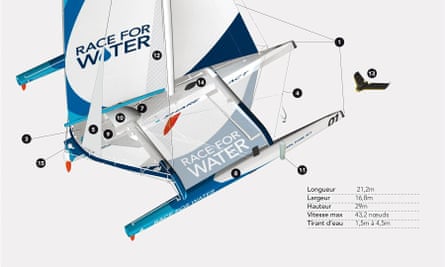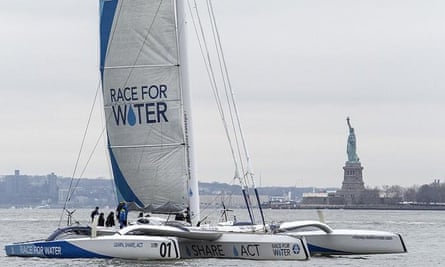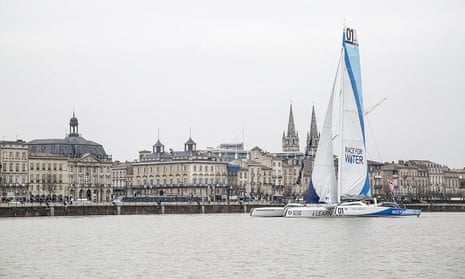Race for the Water, a Swiss marine research expedition focused on plastic pollution, last week announced its plan to collect and analyze samples of plastic found on the world’s most remote island beaches. Over a trip of 40,000 nautical miles, the crew will use drones to conduct its work. Those drones will fly over beaches to collect information on how much plastic has collected there.
In the coming year, the team hopes to collect information that could stem the flow of plastic debris into the world’s oceans. By creating a repeatable research protocol, it hopes to address three research needs laid out by the Honolulu Strategy, an international framework for addressing global marine plastic pollution adopted in 2010 by the US National Oceanic and Atmospheric Administration (NOAA) and the United Nations. These include: standardized research protocols for marine debris, repeatable and comparable studies, and data-based solutions.
The use of drones could be helpful for NOAA, according to Nancy Wallace, the director of the agency’s marine debris program. Wallace says she needs a time-lapse look of micro debris on the beaches and that right now the only way to get it is to have people comb beaches and count – a costly and time-consuming affair. Sending drones to perform the task instead would save time and money, in addition to providing more data.
Funded primarily by Marco Simeoni, a Swiss entrepreneur turned environmental crusader, Race for the Water is also determined to inject a spirit of adventure into an otherwise depressing issue. “We say OK, this is a problem we have to solve together, let’s make it an adventure,” Servan-Shcreiber says. “It’s about being human and facing problems together. That’s why we like [our] boat.”
The boat is a racing catamaran that Servan-Schreiber describes as “incredibly uncomfortable,” with no toilet onboard, no lighting in the hallways, two bunk beds for six people, and only two small gas burners for preparing food. It’s not a logical choice for such an expedition, but that’s the point.
“These guys have to wear mining lights on their heads to walk down the hallway, and Marco never believed the boat could make it around the world – he gets sea sick on it constantly, but he’s sticking with it,” Servan-Schreiber says. “These guys are really gladiators for the environment, and the expedition is a great human story.”

Beaches versus blue water
While several groups have taken to the seas to both raise awareness and gather information about plastic pollution – including 5 Gyres, Project Kaisei, Plastiki, Algalita and the Clean Oceans Project – one of the issues spotlighted in the Honolulu Strategy is the fact that each research expedition tends to employ different protocols, and there is often quite a bit of time between samples taken, which makes it difficult to both compare the results of various studies, and to replicate the results of any one study.
In some ways, that inconsistency is just the nature of the beast, or rather, the ocean. In addition to the fact that each expedition needs to find funding – for tools, boats, staff, and laboratory analysis – most have also focused on collecting samples from the open ocean, which is challenging, especially when weather and currents don’t cooperate. 5 Gyres has run more expeditions more frequently than most organizations, and has documented the presence of approximately 268,000 tons of plastic in all five of the world’s ocean gyres (large circular networks of ocean currents), and maintains an updated map of global plastic pollution. Still, co-founder and research director Marcus Eriksen says he’s had challenges over the years collecting data on various boats in every ocean condition imaginable.
By focusing on beaches rather than the open water, and using the drones to go back frequently and map changes over time, Servan-Schreiber hopes Race for the Water may be able to close the research gap.
“We think going to the islands gives us a very good way to study the five gyres without having to do the same as everybody else and get samples from blue water,” he says. “We think what we find on the beach, we’ll find in the water. And the good thing about the islands is that we can come back again and again and get a sense over time of how the problem is evolving.”

Finding solutions
The team plans to send samples to a lab in Lausanne, Switzerland – Race for the Water’s home base – to determine which chemicals have accumulated in the plastic and at what levels. The fact that plastic in the ocean attracts and accumulates chemicals is well established, but the Lausanne lab will attempt to pinpoint how this process happens over time, and what level of chemical toxicity should be expected in the world’s oceans over time. That’s important because fish and birds consume microplastics, which can poison not only the animals, but also the humans who eat them.
It’s even a concern for people who might consider themselves fairly removed from the ocean ecosystem, Servan-Schreiber explains. “This week I’m in Miami and last week I was in Rio, and every beach I go to, all over the world, there are tiny bits of plastic in the sand,” he says. “And yet kids are playing on it and it’s shocking, in a way, that we are letting kids play on beaches that are actually contaminated.”
Over time, plastic on beaches could potentially leech not only the chemicals used to make the plastic in the first place, but also any additional chemicals accumulated in the ocean. While short term exposure has not indicated any health issues related to ocean plastic, Servan-Schreiber points out that we don’t know what long term exposure may do.
Servan-Schreiber says the team rejected the idea of recycling the plastic they collect because recycling marine plastic pollution requires a lot of fresh water to clean off the salt, making it inefficient and wasteful. Instead, the team is focusing its energy on identifying large-scale solutions. Cigarette butts, for example, are coated in plastic and thus never break down – they make up more than 40% of the debris found on beaches. “So maybe that’s an argument for e-cigarettes,” Servan-Schreiber says.
Plastic bottle caps are another issue. Although beverage bottles are ubiquitous, their caps tend to be a bigger issue because they are colorful and just the right size for birds, fish, and marine mammals to eat. So the Race for the Water team is looking at whether a new sort of top could be designed for plastic bottles.
They are also finding inspiration at home in Lausanne, where a factory in the middle of the city burns plastic debris to generate energy. The factory is equipped with a filter that keeps any related toxins out of the air.
“We have to find ways to make value out of marine debris,” Servan-Schreiber says. “It could sound good to recycle it, but it isn’t. Once we looked at it, turned out burning it to create electricity and heat is probably the best option. But that’s just one of the ideas out of this, and we’re just at the beginning.”
Ultimately, the goal is to find viable solutions and put as many of them in place as possible.
“Because plastic never goes away, at some point, the beaches will be more plastic than sand,” Servan-Schreiber says. “So it’s better to realize that very early and try to mitigate the problem.”

Comments (…)
Sign in or create your Guardian account to join the discussion